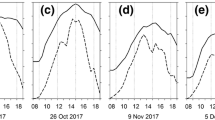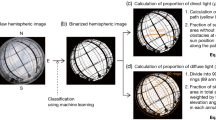Abstract
The amount of photosynthetically active radiation (PAR, 0.4–0.7 μm) absorbed by plants for photosynthesis relative to incident radiation is defined as the fraction of absorbed photosynthetically active radiation (fAPAR). This is an important variable in both plant biomass production and plant growth modeling. This study investigates the application of a newly developed, linear irradiance sensor (LightScout Quantum Bar Sensor, LightScout, Spectrum Technologies, Inc. USA), to quantify fAPAR for a demonstrator crop, Triticale (X Triticosecale Wittmack). A protocol was devised for sensor placement to determine reflected PAR components of fAPAR and to determine the optimal time of day and sensor orientation for data collection. Coincident, top of canopy, normalized difference vegetation index (NDVI) measurements were also acquired with a CropCircle™ ACS-210 sensor and measurements correlated with derived fAPAR values. The optimum height of the linear irradiance sensor above soil or plant canopy was found to be 0.4 m while measuring reflected PAR. Measurement of fAPAR was found to be stable when conducted within 1 h of local solar noon in order to avoid significant bidirectional effects resulting from diurnal changes of leaf orientation relative to the vertically-placed sensor. In the row crop studied, averaging fAPAR readings derived from the linear irradiance sensor orientated across and along the plant row provided an R2 = 0.81 correlation with above-canopy NDVI. Across row sensor orientation also gave a similar correlation of R2 = 0.76 allowing the user to reduce sampling time.






Similar content being viewed by others
References
Allen, L. H., Yocum, C. S., & Lemon, E. R. (1964). Photosynthesis under field conditions. VII. Radiant energy exchanges within a corn crop canopy and implications in water use efficiency. Agronomy Journal, 56(3), 253–259. doi:10.2134/agronj1964.00021962005600030002x.
Arkin, G. F., Ritchie, J. T., & Mass, S. J. (1978). A model for calculating light interception by a grain sorghum canopy. Transactions of the American Society of Agricultural Engineers, 21(2), 303–308.
Asrar, G., Fuchs, M., Kanemasu, E. T., & Hatfield, J. L. (1984). Estimating absorbed photosynthetic radiation and leaf area index from spectral reflectance in wheat. Agronomy Journal, 76(2), 300–306. doi:10.2134/agronj1984.00021962007600020029x.
Asrar, G., Myneni, R. B., & Choudhury, B. J. (1992). Spatial heterogeneity in vegetation canopies and remote sensing of absorbed photosynthetically active radiation: A modeling study. Remote Sensing of Environment, 41(2–3), 85–103. doi:10.1016/0034-4257(92)90070-z.
Baker, D. N., & Musgrave, R. B. (1964). Photosynthesis under field conditions. V. Further plant chamber studies of the effect of light on corn (Zea mays L.). Crop Science, 4(2), 127–131. doi:10.2135/cropsci1964.0011183X000400020001x.
Baret, F., & Guyot, G. (1991). Potentials and limits of vegetation indices for LAI and APAR assessment. Remote Sensing of Environment, 35(2–3), 161–173. doi:10.1016/0034-4257(91)90009-u.
Bégué, A., Hanan, N. P., & Prince, S. D. (1994). Radiative transfer in shrub savanna sites in Niger—preliminary results from HAPEX-II-Sahel II. PAR interception of the woody layer. Agricultural and Forest Meteorology, 69, 247–266.
Daughtry, C. S. T., Gallo, K. P., & Bauer, M. E. (1983). Spectral estimates of solar radiation intercepted by corn canopies. Agronomy Journal, 75(3), 527–531. doi:10.2134/agronj1983.00021962007500030026x.
Daughtry, C. S. T., Gallo, K. P., Goward, S. N., Prince, S. D., & Kustas, W. P. (1992). Spectral estimates of absorbed radiation and phytomass production in corn and soybean canopies. Remote Sensing of Environment, 39(2), 141–152. doi:10.1016/0034-4257(92)90132-4.
Drolet, G. G., Huemmrich, K. F., Hall, F. G., Middleton, E. M., Black, T. A., Barr, A. G., et al. (2005). A MODIS-derived photochemical reflectance index to detect inter-annual variations in the photosynthetic light-use efficiency of a boreal deciduous forest. Remote Sensing of Environment, 98(2–3), 212–224. doi:10.1016/j.rse.2005.07.006.
Gallo, K. P., & Daughtry, C. S. T. (1986). Techniques for measuring intercepted and absorbed photosynthetically active radiation in corn canopies. Agronomy Journal, 78, 752–756.
Gallo, K. P., Daughtry, C. S. T., & Bauer, M. E. (1985). Spectral estimation of absorbed photosynthetically active radiation in corn canopies. Remote Sensing of Environment, 17(3), 221–232. doi:10.1016/0034-4257(85)90096-3.
Hanan, N. P., & Bégué, A. (1995). A method to estimate instantaneous and daily intercepted photosynthetically active radiation using a hemispherical sensor. Agricultural and Forest Meteorology, 74, 155–168.
Hipps, L. E., Asrar, G., & Kanemasu, E. T. (1983). Assessing the interception of photosynthetically active radiation in winter wheat. Agricultural Meteorology, 28(3), 253–259. doi:10.1016/0002-1571(83)90030-4.
Holland, K. H., Lamb, D. W., & Schepers, J. S. (2012). Radiometry of proximal active optical sensors (AOS) for agricultural sensing. IEEE Journal of Selected Topics in Applied Earth Observations and Remote Sensing, 5(6), 1–10. doi:10.1109/JSTARS.2012.2198049.
Holland, K. H., Schepers, J. S., Shanahan, J. F., & Horst, G. L. (2004). Plant canopy sensor with modulated polychromatic light source. Paper presented at the proceedings of the 7th international conference on precision agriculture and other precision resources management. University of Minnesota, Department of Soil, Water and Climate, St Paul, MN, USA.
Lamb, D. W., Trotter, M. G., & Schneider, D. A. (2009). Ultra low-level airborne (ULLA) sensing of crop canopy reflectance: A case study using a CropCircle™ sensor. Computers and Electronics in Agriculture, 69(1), 86–91. doi:10.1016/j.compag.2009.07.004.
McCree, K. J. (1972). Test of current definitions of photosynthetically active radiation against leaf photosynthesis data. Agricultural Meteorology, 10, 443–453. doi:10.1016/0002-1571(72)90045-3.
Myneni, R. B., & Williams, D. L. (1994). On the relationship between FAPAR and NDVI. Remote Sensing of Environment, 49(3), 200–211. doi:10.1016/0034-4257(94)90016-7.
Pinter, P. J, Jr. (1993). Solar angle independence in the relationship between absorbed PAR and remotely sensed data for alfalfa. Remote Sensing of Environment, 46(1), 19–25. doi:10.1016/0034-4257(93)90029-w.
Pitman, A. J. (2003). The evolution of, and revolution in, land surface schemes designed for climate models. International Journal of Climatology, 23(5), 479–510. doi:10.1002/joc.893.
Rao, V. R., Brach, E. J., & Mack, A. R. (1979). Bidirectional reflectance of crops and the soil contribution. Remote Sensing of Environment, 8, 115–125.
Ross, R., & Marshak, A. (1989). The influence of leaf orientation and the specular component of leaf reflectacne on the canopy bidirectional reflectance. Remote Sensing of Environment, 27, 251–260.
Rouse, J. W., Haas, R. H., Schell, J. A., & Deering, D. W. (1973). Monitoring vegetation systems in the great plains with ERTS. Paper presented at the proceedings of the third ERTS symposium, Washington, DC.
Running, S. W., Nemani, R. R., Heinsch, F. A., Zhao, M., Reeves, M., & Hashimoto, H. (2004). A continuous satellite-derived measure of global terrestrial primary production. BioScience, 54(6), 547–560.
Sellers, P. J. (1985). Canopy reflectance, photosynthesis and transpiration. International Journal of Remote Sensing, 6(8), 1335–1372. doi:10.1080/01431168508948283.
Sellers, P. J., Dickinson, R. E., Randall, D. A., Betts, A. K., Hall, F. G., Berry, J. A., et al. (1997). Modeling the exchanges of energy, water, and carbon between continents and the atmosphere. Science, 275(5299), 502–509. doi:10.1126/science.275.5299.502.
Suits, G. H. (1972). The cause of azimuthal variations in directional reflectance of vegetative canopies. Remote Sensing of Environment, 2, 175–182.
Viña, A., & Gitelson, A. A. (2005). New developments in the remote estimation of the fraction of absorbed photosynthetically active radiation in crops. Geophysical Reseach Letters, 32(17), L17403. doi:10.1029/2005gl023647.
Walthall, C. L., Norman, J. M., Welles, J. M., Campbell, G., & Blad, B. L. (1985). Simple equation to approximate the bidirectional reflectance from vegetative canopies and bare soil surfaces. Applied Optics, 24(3), 383–387.
Wiegand, C. L., Richardson, A. J., Escobar, D. E., & Gerbermann, A. H. (1991). Vegetation indices in crop assessments. Remote Sensing of Environment, 35(2–3), 105–119. doi:10.1016/0034-4257(91)90004-p.
Williams, W. A., Loomis, R. S., & Lepley, C. R. (1965). Vegetative of corn as affected by population density. I. Productivity in relation to interception of solar radiation. Crop Science, 5(3), 211–215. doi:10.2135/cropsci1965.0011183X000500030004x.
Zadoks, J. C., Chang, T. T., & Konzak, C. F. (1974). A decimal code for the growth stages of cereals. Weed Research, 14(6), 415–421. doi:10.1111/j.1365-3180.1974.tb01084.x.
Acknowledgments
The authors would like to acknowledge the receipt of an International Postgraduate Research Scholarship (Rahman) to conduct this study. This work was partially funded by the CRC for Spatial Information (CRCSI), established and supported under the Australian Government’s Cooperative Research Centres Programme. The authors gratefully acknowledge the assistance of Derek Schneider (UNE-PARG/CRCSI) for technical assistance in configuring the instruments for fieldwork.
Author information
Authors and Affiliations
Corresponding author
Rights and permissions
About this article
Cite this article
Rahman, M.M., Stanley, J.N., Lamb, D.W. et al. Methodology for measuring fAPAR in crops using a combination of active optical and linear irradiance sensors: a case study in Triticale (X Triticosecale Wittmack). Precision Agric 15, 532–542 (2014). https://doi.org/10.1007/s11119-014-9349-6
Published:
Issue Date:
DOI: https://doi.org/10.1007/s11119-014-9349-6




